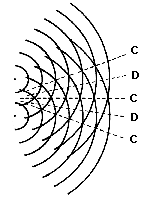
 |
Interference |
When sound waves from two different sources at the same frequency strike one another, pressure displacements occur which are the sum and the difference of the amplitudes of the two waves.
Where the crests of one set of waves coincide with the crests of another set, the amplitude is increased. This is called constructive interference (the lines indicated by C on the diagram). Where the crests of one set fall on the troughs of the other, i.e. they are 180° out of phase, the two will cancel one another and the resulting amplitude is decreased. This is called destructive interference or cancellation (the lines indicated by D on the diagram).
See: Compression, Rarefaction.
Beats and phasing are examples of interference effects. Another important type of interference results in standing waves and dead spots, and occurs when two waves of the same frequency and amplitude travel in opposite directions. Interference also causes ground effect in outdoor situations (see sound propagation).
See: Diffusion, Law of Superposition, Phase-Shift. Compare: Diffraction, Sound Shadow.

Interference pattern between the wave fronts of
two sound sources. Constructive interference is indicated by lines C,
and destructive interference by lines D.
